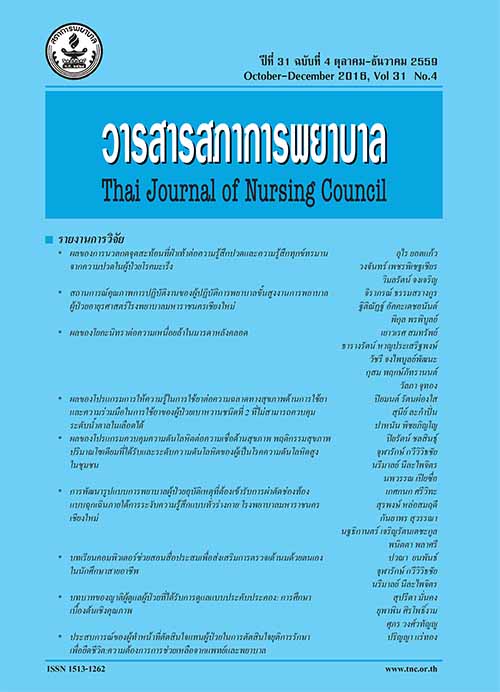สถานการณ์คุณภาพการปฏิบัติงานของผู้ปฏิบัติการพยาบาลขั้นสูง งานการพยาบาลผู้ป่วยอายุรศาสตร์โรงพยาบาลมหาราชนครเชียงใหม; Situation of the Performance Quality of Advanced Practice Nurses in the Medical Care Section, Maharaj Nakorn Chiang Mai Hospital
Keywords:
การวิเคราะห์สถานการณ์, คุณภาพการปฏิบัติงาน, ผู้ปฏิบัติการพยาบาลขั้นสูง, situational analysis, practice quality, Advanced Practice NursesAbstract
บทคัดย่อ: วัตถุประสงค์: เพื่ออธิบายสถานการณ์คุณภาพการปฏิบัติงานของผู้ปฏิบัติการพยาบาลขั้นสูง
งานการพยาบาลผู้ป่วยอายุรศาสตร์ โรงพยาบาลมหาราชนครเชียงใหม่
การออกแบบการวิจัย: การศึกษาเชิงพรรณนา (descriptive study)
วิธีดำเนินการวิจัย:กลุ่มตัวอย่างในการศึกษาครั้งนี้เลือกแบบเจาะจง ประกอบด้วย ผู้บริหารทางการพยาบาล 2 คน หัวหน้าหอผู้ป่วย/หัวหน้าหน่วย 8 คน ผู้ปฏิบัติการพยาบาลขั้นสูง 15 คน บุคลากรด้านสุขภาพที่ปฏิบัติงานร่วมกับผู้ปฏิบัติการพยาบาลขั้นสูง 4 คน ผู้ป่วย 2 คน และเอกสารที่เกี่ยวข้องกับการปฏิบัติงานของผู้ปฏิบัติกำรพยาบาลขั้นสูง กรอบแนวคิดในการศึกษาครั้งนี้ ใช้กรอบแนวคิดคุณภาพการดูแลสุขภาพของโดนาบีเดียน เครื่องมือที่ใช้ในกำรรวบรวมข้อมูลใช้แนวคำถามแบบกึ่งโครงสร้างในการสัมภาษณ์รายบุคคลและการสนทนากลุ่ม วิเคราะห์ข้อมูลโดยใช้สถิติเชิงพรรณนำและวิเคราะห์เนื้อหา
ผลการวิจัย: 1. ด้านโครงสร้าง พบว่าฝ่ายการพยาบาลมีนโยบายการปฏิบัติงานของผู้ปฏิบัติการพยาบาลขั้นสูง แต่กำหนดนโยบายลงสู่การปฏิบัติในแต่ละหอผู้ป่วยมีความแตกต่างกันขึ้นอยู่กับการมอบหมายงาน บันไดความก้าวหน้ายังไม่ชัดเจน การกระจายอัตรากำลังของผู้ปฏิบัติการพยาบาลขั้นสูงไม่เหมาะสม รูปแบบการปฏิบัติงานของผู้ปฏิบัติการพยาบาลขั้นสูงมีสามรูปแบบได้แก่ ปฏิบัติงานในบทบาทเต็มเวลา ใช้เวลาบางส่วนในการปฏิบัติบทบาท และใช้เวลาส่วนตัวในการปฏิบัติบทบาท สถานที่และสิ่งอำนวยความสะดวกในการปฏิบัติงานของผู้ปฏิบัติการพยาบาลขั้นสูงมีไม่เพียงพอ การนิเทศการปฏิบัติงานของผู้ปฏิบัติการพยาบาลขั้นสูงไม่มีแนวปฏิบัติที่ชัดเจน และไม่ได้กำหนดผู้รับผิดชอบในกำรนิเทศ ค่าตอบแทนไม่เหมาะสมกับความรู้ ความสามารถ และภาระงาน
2. ด้านกระบวนการ พบว่า ผู้ปฏิบัติการพยาบาบขั้นสูงให้การดูแลผู้ป่วยตามสมรรถนะ
ทั้ง 9 ตามที่สภาการพยาบาลกำหนด แต่จะปฏิบัติได้มากหรือน้อยขึ้นอยู่กับลักษณะของผู้ป่วยที่เป็น
ประชากรกลุ่มเป้าหมาย และการมอบหมายงานของหัวหน้าหอผู้ป่วย
3. ด้านผลลัพธ์ พบว่า การปฏิบัติงานของผู้ปฏิบัติการพยาบาลขั้นสูงทำให้เกิด ผลลัพธ์
ที่ดีต่อผู้ใช้บริการ/ผู้ป่วย ต่อผู้ให้บริกำร และต่อองค์กร แต่แนวปฏิบัติในกำรติดตำมผลลัพธ์ยังไม่ชัดเจน
ข้อเสนอแนะ: สำหรับผู้บริหารทางการพยาบาล ควรกำหนดผู้รับผิดชอบดูแลผู้ปฏิบัติการพยาบาลขั้นสูงอย่างเป็นลายลักษณ์อักษร กำหนดบทบาทหน้าที่และความก้าวหน้าของผู้ปฏิบัติการพยาบาลขั้นสูงแต่ละระดับให้มีความชัดเจน ส่งเสริมและสนับสนุนให้ผู้ปฏิบัติการพยาบาลขั้นสูงได้ปฏิบัติบทบาทตามสมรรถนะที่สภาการพยาบาลกำหนด จัดหาปัจจัยสนับสนุนในการปฏิบัติงานและการสร้างผลงานทางวิชชาการของผู้ปฏิบัติการพยาบาลขั้นสูง นำผลลัพธ์ที่ได้ มาใช้ในการพัฒนาคุณภาพการบริหารหรือปรับเปลี่ยนนโยบายตามความเหมาะสม
Abstract: Objective: To describe the situation in relation to the performance quality of advanced
practice nurses in the Medical Care Section of Maharaj Nakhon Chiangmai Hospital.
Design: Descriptive study.
Implementation: This study was conducted on a purposively sampled population consisting
of 2 administrative nurses, 8 matrons/section heads, 15 advanced practice nurses, 4 healthcare staff
members assisting the advanced practice nurses, and 2 patients. Additional data were collected
from documents relevant to the advanced practice nurses’ performance of their duties. The conceptual
framework for this study was developed according to the Donabedian Healthcare Model. The
data-collecting instruments were individual semi-structured interviews and group discussions.
Descriptive statistics and content analysis were used for data analysis.
Results: Structural Aspect: Despite the Nursing Section’s policies concerning the advanced
practice nurses’ duty performance, the translation of the policies into practice varied from ward to ward.
The major factors contributing to such discrepancies were (1) unclear career paths and (2) unbalanced
distribution of advanced practice nurses. The study found that the advanced practice nurses performed
their duties in 3 ways: (1) performing their duties full-time; (2) performing their duties part-time;
and (3) performing their duties during their private time. It was also found that there were insuffcient
facilities to support the advanced practice nurses’ performance of duties, unclear guidelines for the
inspection of the advanced practice nurses’ performance, absence of appointment of performance
inspectors, and disproportion between the nurses’ salaries and their knowledge, skills and workloads.
Process Aspect: The advanced practice nurses gave their patients care based on the 9 areas
of competency, as stipulated by the Thailand Nursing and Midwifery Council. However, the extent
to which the nurses could perform their duties was determined by the characteristics of their patients
(target population) and by the matrons’ assignment of tasks.
Outcomes: The advanced practice nurses’ duty performance created positive outcomes
that benefted the service recipients (patients), fellow service-providing staff members, and
the organisation. However, there was no clear outcome follow-up procedure in place.
Recommendations: It is recommended that administrative nurses (1) appoint, in writing,
supervisors for advanced practice nurses; (2) clearly specify the roles, duties and career paths
for advanced practice nurses at each level; (3) support and encourage advanced practice nurses
to perform their tasks according to the areas of competency required by the Thailand Nursing and
Midwifery Council; (4) provide supporting facilities to encourage advanced practice nurses’ duty
performance or creation of academic works; and (5) apply the outcomes of the above-recommended
actions to the improvement of administrative quality or any appropriate adjustment of policies








